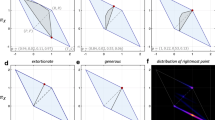Summary.
This paper contributes to the recent focus on dynamics in noncooperative games when players use inductive learning. The most well-known inductive learning rule, Brown’s fictitious play, is known to converge for games, yet many examples exist where fictitious play reasoning fails to converge to a Nash equilibrium. Building on ideas from chaotic dynamics, this paper develops a geometric conceptualization of instability in games, allowing for a reinterpretation of existing results and suggesting avenues for new results.
Similar content being viewed by others
Author information
Authors and Affiliations
Additional information
Received: October 27, 1995 revised version May 2, 1996
Rights and permissions
About this article
Cite this article
Richards, D. The geometry of inductive reasoning in games. Economic Theory 10, 185–193 (1997). https://doi.org/10.1007/s001990050153
Issue Date:
DOI: https://doi.org/10.1007/s001990050153




